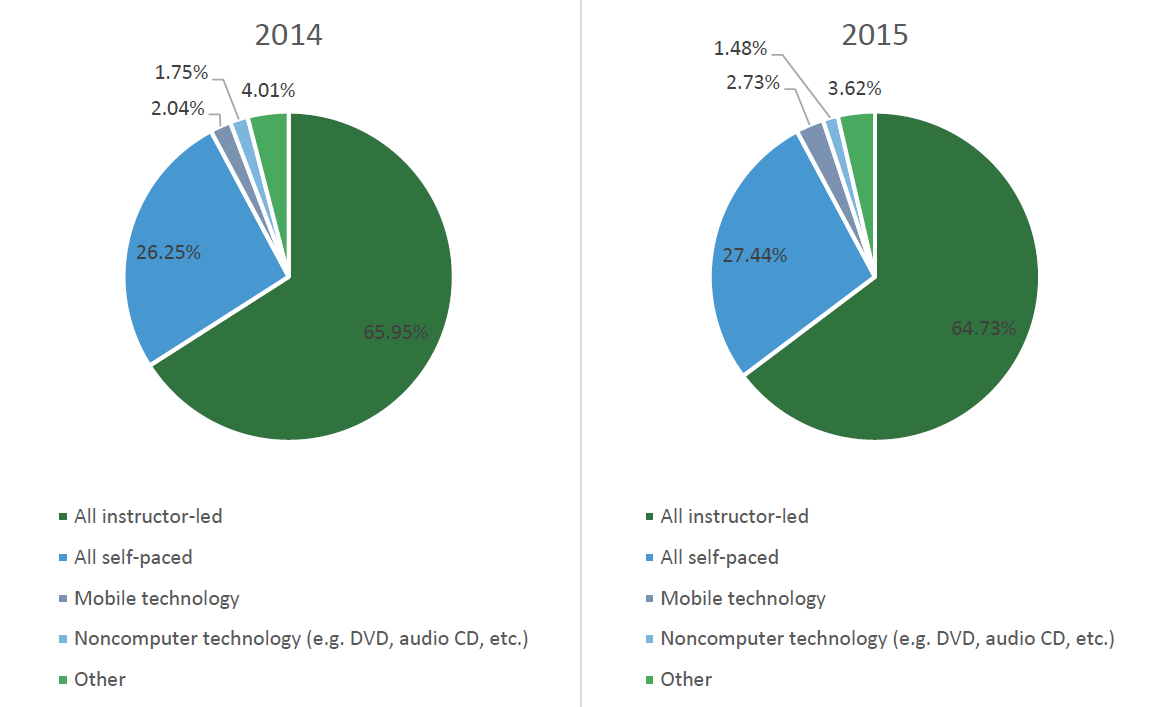- Live & Recorded Events
Remote Work Trends: Instructor-Led Training Is Going Virtual
Face-to-face, instructor-led training (ILT) has long been the dominant method used for employee training and development. The advantages of learning directly from experts are clear: instructors can easily adapt to learners’ needs, learners focus more on the subject materials, and the learners have the ability to receive immediate feedback.
But the use of face-to-face ILT in corporate classrooms has been declining, and 2015 marked a milestone. Less than half (49%) of all learning was instructor-led in a classroom without a virtual learning component. According to data collected yearly by the Association for Talent Development (ATD), this figure has been on a steady decline over the last seven years. In 2010, traditional ILT accounted for 59% of all corporate learning hours.

Why Is Traditional Instructor-Led Classroom Training Declining?
Traditional, face-to-face ILT can provide employees with unparalleled interactivity in the learning experience. However, it carries two disadvantages: time and cost. As new learning technologies improve efficiency and lower the cost of training per employee, many courses commonly delivered via traditional corporate learning have begun shifting from the physical classroom to virtual training methods.
Accounting for both virtual and in-person ILT, instructor-led training still accounts for 65% of all corporate training methods. The good news for learning and development teams is that decreases in classroom-based ILT in recent years have been offset by blended, technology-based corporate learning programs. Instructor-led training isn’t going away, but rather, it’s embracing new technologies that make training more impactful and scalable.

E-Learning Adoption Climbs Upward, Especially in Larger Organizations
While traditional ILT slipped, ATD’s report showed that e-learning methods, including instructor-led e-learning, grew to account for 42% of the learning hours used in 2015. The trend was even more pronounced in larger organizations, where learning and development teams delivered 49% of training using some form of e-learning technology.
The trend in corporate e-learning training methods is interesting – likely influenced by the early adoption of enterprise e-learning technologies within larger organizations.
Large corporations, with comparatively more to gain from e-learning efficiencies, have led the adoption of e-learning technologies. Smaller businesses, meanwhile, have not been as quick to convert traditional instructor-led learning to computer-based learning, relying more on both traditional and blended instructor-led training.
A similar survey performed by Training Magazine in 2016 showed the breakdown of training delivery methods by company size:

As e-learning technologies evolve and become more accessible to smaller organizations, though, we expect to see more growth in the rate at which technology is used for corporate learning.
How much could you save
with video-based e-learning?
Calculate Your Savings
Converting Instructor-Led Training to e-Learning
Video presentation tools are driving much of the shift from traditional in-class training to on-demand, technology-assisted e-learning within businesses. In many cases, making the switch to more efficient, virtual instructor-led training is as simple as finding the right toolset for your company.
Try Panopto Express, a free video and screen recorder that works right in your browser. Just click here to start recording >>
Video, in particular, has proven time and again to give learning and development teams a flexible system that can help trainers improve learning throughout their organizations. Here are just a few of the ways organizations are using video to support and scale training programs today:
Recording On-Demand Materials
New technologies are minimizing the resources and skills required to record on-demand, multimedia-supported training videos. With no more than the webcam and microphone included standard in most laptops, trainers and subject matter experts can capture all of the materials they might typically present to a live classroom, such as PowerPoint slides and screen sharing, along with the audio and video of the instructor.
Live Broadcasting to Remote Employees & More
From company all-hands meetings to external company communications, some enterprise video solutions can broadcast your videos live with the click of a button. Compared to web conferencing tools like GoToMeeting and WebEx, a video solution that also has a built-in webcasting feature can deliver better quality, scalability and interactivity than most web conferencing tools.
Centralizing Video Content For Easier Discovery
Training videos can be more easily accessed, searched and shared within a video content management system (video CMS) or a corporate YouTube. While YouTube is for public-facing video communications, having your own corporate YouTube allows you to share private video content with employees across your organization and limit access where necessary.
Supporting Just-In-Time Social Learning
Social and collaborative learning is one of the most natural forms of knowledge sharing within an organization. Often more informal, social learning from conversation and collaboration across teams typically occurs when knowledge is needed, and it allows the learner to apply new skills to solve a problem instantly. Video can make it easier for employees to both share knowledge and find it, supporting social learning across teams, departments and locations.
Mobile Learning In The Field
Very few businesses appear to be taking advantage of mobile learning technology. According to ATD’s State of the Industry survey, less than 3% of businesses reported using mobile technologies for employee learning and development. Some video platforms can give your employees the option to view video content on any device, including smartphones and tablets. For many businesses with employees in the field, the ability to access on-demand video content from mobile devices can significantly improve sales and service.
 Overcoming The Top 5 Challenges To Training With Video
Overcoming The Top 5 Challenges To Training With Video
If you’re looking to enhance instructor-led training within your company, video may be the best technology to increase the quality, speed, and effectiveness of your employee training efforts. But many companies still struggle to make video work for them. Why?
In our latest white paper, we look at the top 5 challenges businesses face when it comes to training with video and show you how a video content management system solves those problems. In fact, a video CMS can be your own private, secure YouTube for training videos.
Download the white paper to learn more >>
Or watch the webinar on-demand >>


